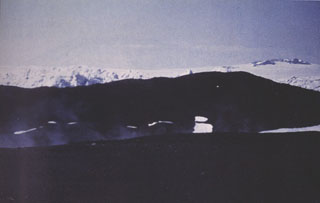Report on Seal Nunataks Volcanic Field (Antarctica) — September 1982
Scientific Event Alert Network Bulletin, vol. 7, no. 9 (September 1982)
Managing Editor: Lindsay McClelland.
Seal Nunataks Volcanic Field (Antarctica) Two previously unknown recent volcanoes identified
Please cite this report as:
Global Volcanism Program, 1982. Report on Seal Nunataks Volcanic Field (Antarctica) (McClelland, L., ed.). Scientific Event Alert Network Bulletin, 7:9. Smithsonian Institution. https://doi.org/10.5479/si.GVP.SEAN198209-390050
Seal Nunataks Volcanic Field
Antarctica
65.03°S, 60.05°W; summit elev. 368 m
All times are local (unless otherwise noted)
In January 1982, geologists from the Universidad de Chile found evidence of recent volcanism at two sites in the Seal Nunataks Group that had not previously been identified as recent volcanic centers. At Dallman (65.02°S, 60.32°W), very fresh-looking basaltic lava had emerged from the central crater and flowed to the NW foot of the volcano. Active fumaroles were observed at the N side of the summit. Abundant basaltic lapilli and ash covered wide areas of the Larsen Ice Shelf in the vicinity of Murdoch Volcano (65.03°S, 60.03°W). Portions of these deposits were covered by fresh snow. Fumaroles were active in a small parasitic cinder cone SE of Murdoch.
In December 1893, C.A. Larsen saw an eruption of black ash from Lindenberg (64.92°S, 59.70°W) and solfataric activity at Christensen (65.10°S, 59.57°W), but no activity was observed at either of these volcanoes in 1982.
Geological Summary. The Seal Nunataks are a group of 16 isolated nunataks emerging from the Larsen Ice Shelf east of Graham Land Peninsula. Most of the larger nunataks are considered to represent separate volcanic vents erupted in a shallow-water environment. Fumarolic activity was reported from Murdoch and Dallman cones in 1982, and fresh-looking pyroclastics and a lava flow at Dallman (not observed in 1979) were seen on the ice surface three years later (González-Ferrán, 1983). Fumarolic activity was observed at Christensen in 1893, and Lindenberg was observed in eruption in 1893. Baker (1968) saw cinders on the ice surface, suggesting a 20th-century eruption, and similar observations were reported in 1985 and 2010, but these events may have been due to aeolian tephra redistribution. A 1988 British expedition noted that tephra away from nunataks was found only in ice-cored moraines, suggesting a glacial rather than pyroclastic origin. They noted no fumarolic activity, although water vapor resulting from radiant heating of ice-cored moraines was observed.
Information Contacts: O. González-Ferrán, Univ. de Chile.

